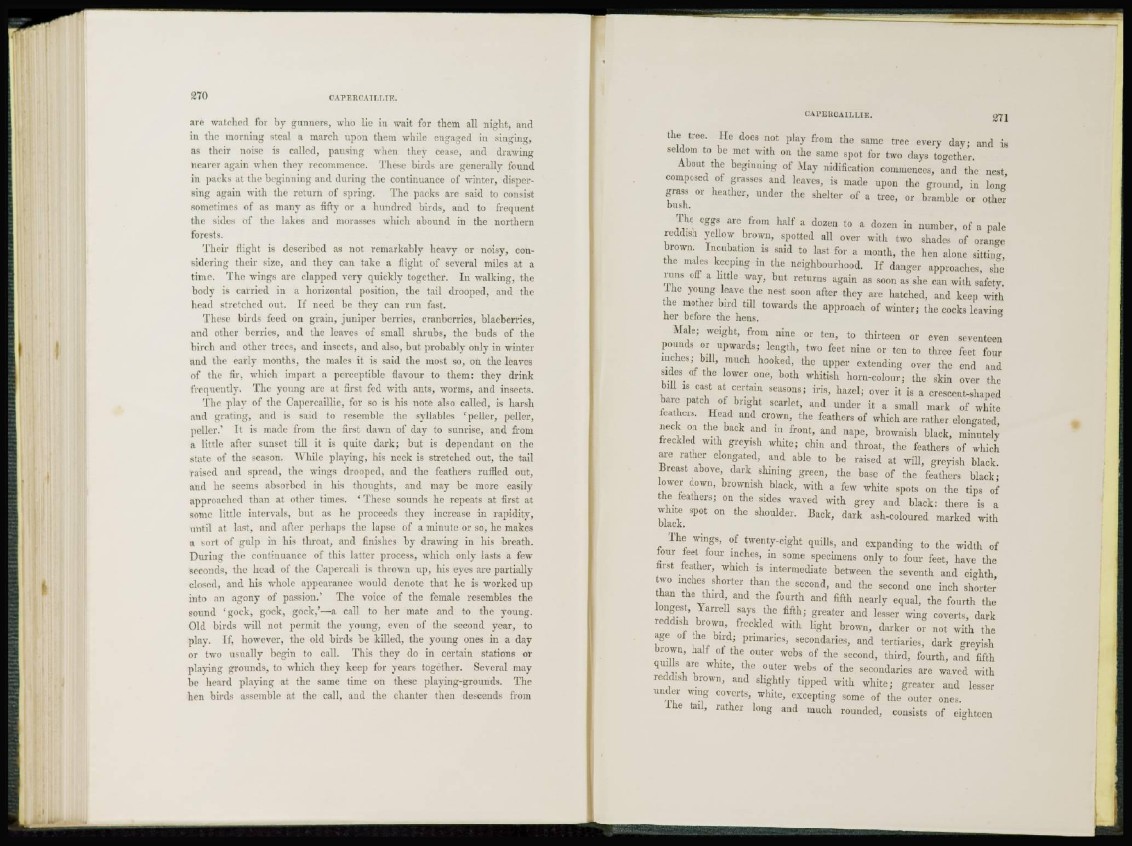
are watched for by gunners, who lie in wait for them all night, and
in the morning steal a march upon them while engaged in singing,
as their noise is called, pausing when they cease, and drawing
nearer again when they recommence. These birds arc generally found
in packs at the beginning and during the continuance of winter, dispersing
again with the return of spring. The packs are said to consist
sometimes of as many as fifty or a hundred birds, and to frequent
the sides of the lakes and morasses which abound in the northern
forests.
Their flight, is described as not remarkably heavy or noisy, considering
their size, and they can take a flight of several miles at a
time. The wings are clapped very quickly- together. In walking, the
body is carried in a horizontal position, the tail drooped, and the
head stretched out. If need be they can run fast.
These birds feed on grain, juniper berries, cranberries, blaeberries,
and other berries, and the leaves of small shrubs, the buds of the
birch and other trees, and insects, and also, but probably only in winter
and the early months, the males it is said the most so, on the leaves
of the fir, which impart a perceptible flavour to them: they drink
frequently. The young arc at first fed with ants, worms, and insects.
The play of the Caporcaillic, for so is his note also called, is harsh
and grating, and is said to resemble the syllables '"poller, pcllcr,
poller.1 It is made from the first dawn of day to sunrise, and from
a little after sunset till it is quite dark; but is dependant on the
state of the season. While playing, his neck is stretched out, the tail
raised and spread, the wings drooped, and the feathers ruffled out,
and he seems absorbed in his thoughts, and may be more easily
approached than at other times. 'These sounds he repeats at first at
some little intervals, but as he proceeds they increase in rapidity,
until at last, and after perhaps the lapse of a minute or so, he makes
a sort of gulp in his throat, and finishes by drawing in his breath.
During the continuance of this latter process, which only lasts a few
seconds, the head of the Capercali is thrown up, his eyes are partially
closed, and his whole appearance wTould denote that he is worked up
into an agony of passion.' The voice of the female resembles the
sound 'gock, gock, gock,'—a call to her mate and to the young.
Old birds will not permit the young, even of the second year, to
play. If, however, the old birds be killed, the young ones in a day
or two usually begin to call. This they do in certain stations or
playing grounds, to wdiich they keep for years together. Several may
be heard playing at the same time on these playing-grounds. The
hen birds assemble at the call, and the chanter then descends from
CAPE ItC A I L L I E . 271
the tree, lie does not play from the same tree every day; and is
seldom to be met with on the same spot for two days together.
About the beginning of May nidification commences, and the nest,
composed of grasses and leaves, is made upon the ground, in long
grass or heather, under the shelter of a tree, or bramble or other
bush.
The eggs are from half a dozen to a dozen in number, of a pale
reddish yellow brown, spotted all over with two shades of orange
brown. Incubation is said to last for a month, the hen alone sitting,
the males keeping in the neighbourhood. If danger approaches, she
runs off a little way, but returns again as soon as she can with safety.
The young leave the nest soon after they are hatched, and keep with
the mother bird till towards the approach of winter; the cocks leaving
her before the hens.
Male; weight, from nine or ten, to thirteen or even seventeen
pounds or upwards; length, two feet nine or ten to three feet four
inches; bill, much hooked, the upper extending over the end and
sides of the lower one, both whitish horn-colour; the skin over the
bill is cast at certain seasons; iris, hazel; over it is a crescent-shaped
bare patch of bright scarlet, and under it a small mark of white
feathers. Head and crown, the feathers of which are rather elongated,
neck on the back and in front, and nape, brownish black, minutely
freckled with greyish white; chin and throat, the feathers of which
are rather elongated, and able to be raised at will, greyish black.
Breast above, dark shining green, the base of the feathers black;
lower down, brownish black, with a few white spots on the tips of
the feathers; on the sides waved with grey and black: there is a
white spot on the shoulder. Back, dark ash-coloured marked with
black.
The wings, of twenty-eight quills, and expanding to the width of
four feet four inches, in some specimens only to four feet, have the
first feather, which is intermediate between the seventh and eighth,
two inches shorter than the second, and the second one inch shorter
than the third, and the fourth and fifth nearly equal, the fourth the
longest, Yarrell says the fifth; greater and lesser wing coverts, dark
reddish brown, freckled with light brown, darker or not with the
age of the bird; primaries, secondaries, and tertiaries, dark greyish
brown, half of the outer webs of the second, third, fourth, and fifth
quills are white, the outer webs of the secondaries are waved with
reddish brown, and slightly tipped with white; greater and lesser
under wing coverts, white, excepting some of the outer ones.
The tail, rather long and much rounded, consists of eighteen